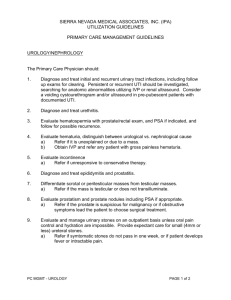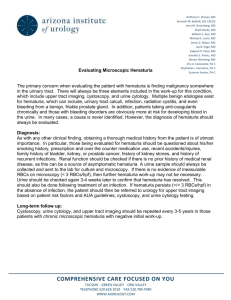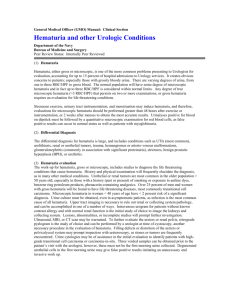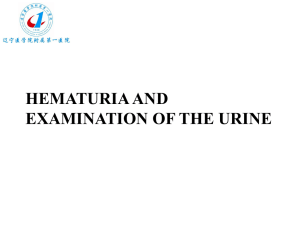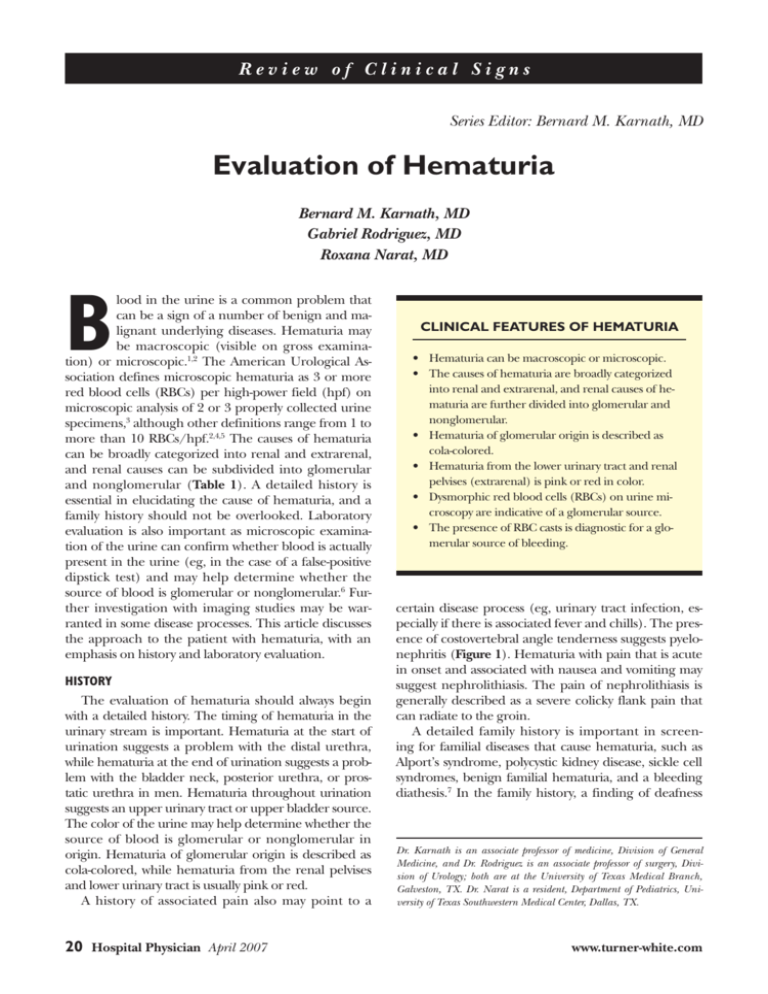
Review of Clinical Signs
Series Editor: Bernard M. Karnath, MD
Evaluation of Hematuria
Bernard M. Karnath, MD
Gabriel Rodriguez, MD
Roxana Narat, MD
B
lood in the urine is a common problem that
can be a sign of a number of benign and malignant underlying diseases. Hematuria may
be macroscopic (visible on gross examination) or microscopic.1,2 The American Urological Association defines microscopic hematuria as 3 or more
red blood cells (RBCs) per high-power field (hpf) on
microscopic analysis of 2 or 3 properly collected urine
specimens,3 although other definitions range from 1 to
more than 10 RBCs/hpf.2,4,5 The causes of hematuria
can be broadly categorized into renal and extrarenal,
and renal causes can be subdivided into glomerular
and nonglomerular (Table 1). A detailed history is
essential in elucidating the cause of hematuria, and a
family history should not be overlooked. Laboratory
evaluation is also important as microscopic examination of the urine can confirm whether blood is actually
present in the urine (eg, in the case of a false-positive
dipstick test) and may help determine whether the
source of blood is glomerular or nonglomerular.6 Fur­ther investigation with imaging studies may be warranted in some disease processes. This article discusses
the approach to the patient with hematuria, with an
emphasis on history and laboratory evaluation.
History
The evaluation of hematuria should always begin
with a detailed history. The timing of hematuria in the
urinary stream is important. Hematuria at the start of
urination suggests a problem with the distal urethra,
while hematuria at the end of urination suggests a problem with the bladder neck, posterior urethra, or prostatic urethra in men. Hematuria throughout urination
suggests an upper urinary tract or upper bladder source.
The color of the urine may help determine whether the
source of blood is glomerular or nonglomerular in
origin. Hematuria of glomerular origin is described as
cola-colored, while hematuria from the renal pelvises
and lower urinary tract is usually pink or red.
A history of associated pain also may point to a
20 Hospital Physician April 2007
Clinical features of hematuria
• Hematuria can be macroscopic or microscopic.
• The causes of hematuria are broadly categorized
into renal and extrarenal, and renal causes of hematuria are further divided into glomerular and
nonglomerular.
• Hematuria of glomerular origin is described as
cola-colored.
• Hematuria from the lower urinary tract and renal
pelvises (extrarenal) is pink or red in color.
• Dysmorphic red blood cells (RBCs) on urine microscopy are indicative of a glomerular source.
• The presence of RBC casts is diagnostic for a glomerular source of bleeding.
certain disease process (eg, urinary tract infection, especially if there is associated fever and chills). The pres­
ence of costovertebral angle tenderness suggests pyelonephritis (Figure 1). Hematuria with pain that is acute
in onset and associated with nausea and vomiting may
suggest nephrolithiasis. The pain of nephrolithiasis is
generally described as a severe colicky flank pain that
can radiate to the groin.
A detailed family history is important in screening for familial diseases that cause hematuria, such as
Alport’s syndrome, polycystic kidney disease, sickle cell
syndromes, benign familial hematuria, and a bleeding
diathesis.7 In the family history, a finding of deafness
Dr. Karnath is an associate professor of medicine, Division of General
Medicine, and Dr. Rodriguez is an associate professor of surgery, Division of Urology; both are at the University of Texas Medical Branch,
Galveston, TX. Dr. Narat is a resident, Department of Pediatrics, University of Texas Southwestern Medical Center, Dallas, TX.
www.turner-white.com
Karnath et al : Evaluation of Hematuria : pp. 20–26, 62
Table 1. Causes of Hematuria
Renal
Glomerular
Thin basement membrane disease (benign familial hematuria)
IgA nephropathy
Alport’s syndrome
Other glomerulonephritides
Nonglomerular
Polycystic kidney disease
Medullary sponge kidney
Papillary necrosis
Pyelonephritis
Sickle cell disease
Renal cell carcinoma
Renal vascular disease
Extrarenal
Figure 1. Computed tomography scan showing an edematous
right kidney (arrow) in a patient with pyelonephritis.
Upper urinary tract
Nephrolithiasis
Ureteral cancer
suggests Alport’s syndrome, a finding of renal failure
suggests polycystic kidney disease, and a finding of easy
bleeding suggests an inherited coagulopathy or platelet disorder. Sickle cell trait or disease is suggested in
young patients with unexplained hematuria who have
ethnic origins from Africa, the Middle East, and Mediterranean countries.8
logic source of bleeding. The presence of RBC casts is diagnostic for a glomerular source of hematuria (Figure 2).
Phase-contrast microscopy is helpful in elucidating the
origin of blood loss when RBC casts are not visualized.
Nonglomerular hematuria is characterized by RBCs that
have an appearance similar to those seen on a peripheral
smear and are uniform in size and shape, while in glomerular hematuria the RBCs have a dysmorphic appearance and are smaller than nonglomerular RBCs.9
A brief discussion of other urinary casts is warranted. Hyaline casts are formed in concentrated urine
from normal components of urine and are considered
benign. White blood cell (WBC) casts can be found
in pyelonephritis and interstitial nephritis. Pigmented
“muddy brown” granular casts and casts containing
tubule epithelial cells are characteristic of acute tubular necrosis and suggest ischemic or nephrotoxic injury. Eosinophiluria (ie, eosinophils comprising
> 5% of urine WBCs) is associated with druginduced allergic interstitial nephritis. Eosinophils can
be seen with Hansel’s or Wright’s stain of the urine.
Crystals may be found in the urine of healthy individuals and in patients with nephrolithiasis.
Laboratory Evaluation
The first question in the laboratory evaluation of
the patient with hematuria is whether blood is actually
present in the urine. False-positive dipstick readings
are common and may be due to detection of myoglobin or contamination of the urine specimen with menstrual blood. All positive urine dipstick tests require
confirmation with microscopic examination.
Urinalysis can usually differentiate a renal from a uro-
Imaging Studies
Imaging studies may be warranted when certain disease processes are suspected such as urolithiasis and
malignancy. These studies include the intravenous pyelogram (IVP; Figure 3), computed tomography (CT), ultrasonography, and magnetic resonance imaging (MRI).10
The IVP historically has been the traditional choice for
evaluating the urinary tract, but it has low sensitivity for
detecting renal and bladder masses and there is a risk
Lower urinary tract
Cystitis
Bladder cancer
Bladder stones
Prostate cancer
Schistosomiasis
Other
Vigorous exercise
Coagulation related
Factitious
False hematuria
www.turner-white.com
Hospital Physician April 2007
21
Karnath et al : Evaluation of Hematuria : pp. 20–26, 62
A
C
Figure 2. Microscopy of urine sediment demonstrating
(A) nondysmorphic red blood cells (black arrows) and a
dysmorphic red blood cell (white arrow), (B) dysmorphic
red blood cells (arrows), and (C) a red blood cell cast.
(Adapted with permission from Agrawal MA, Swartz
R. Acute renal failure. Am Fam Physician 2000;61:2084.
Copyright © 2000 American Academy of Family Physicians.
All rights reserved.)
B
Figure 3. Intravenous pyelogram showing left hydronephrosis
resulting from a stone (arrow) at the ureterovesical junction (the
stone is difficult to visualize).
for nephrotoxicity with contrast media. Renal masses are
best evaluated with ultrasonography, CT, or MRI. Cystoscopy is helpful when investigating bladder lesions.
22 Hospital Physician April 2007
Causes of Hematuria
Malignancy
Common risk factors for urinary malignancy include
age and tobacco use. Although screening for asymptomatic hematuria in adults is not recommended,11
an evaluation is warranted when asymptomatic microscopic hematuria is found.12 Malignancy-associated hematuria tends to be macroscopic and painless but can
be microscopic and painless in early stages of disease.
Renal cell carcinoma, however, can present with flank
pain or may be incidentally discovered while performing an imaging study for another reason.
Renal masses can be a simple cyst, a complex cyst, or
a solid mass (Figure 4). Solid masses are more likely to
represent malignancies. Broadened use of radiologic imaging has increased the incidental detection of renal cell
carcinoma. Incidental tumors may be frequently detected in elderly patients and may carry a better prognosis
than tumors that present with symptoms, as symptomatic
disease correlates with an aggressive histology and advanced disease.13 Symptomatic disease classically presents
with flank pain, palpable flank mass, and hematuria.
Unfortunately, this triad only occurs in approximately
10% of all solid renal masses.13 Other presenting features
of renal cell carcinoma are constitutional symptoms,
paraneoplastic syndromes, and skeletal pain related to
metastatic disease.13,14
www.turner-white.com
Karnath et al : Evaluation of Hematuria : pp. 20–26, 62
Figure 4. Computed tomography scan of the abdomen showing
a nonenhancing benign cystic mass (arrow) of the left kidney.
Cystic Kidney Diseases
Autosomal dominant polycystic kidney disease
(ADPKD). ADPKD is a genetic disorder in which extensive cysts develop in the kidneys (Figure 5) and,
to a lesser extent, in other organs, including the liver,
pancreas, and ovaries. As the cysts enlarge over several
years, the normal renal parenchyma is progressively
destroyed, leading to renal failure. ADPKD is the fourth
most common cause of end-stage renal disease in the
United States, accounting for 5% of all cases.15,16 Hematuria, flank pain, polyuria, nephrolithiasis, urinary
tract infection, and hypertension may be part of the
syndrome associated with ADPKD. In patients with
ADPKD, most episodes of hematuria are due to urinary
tract infections and renal cyst rupture.17
The gene involved in most cases of ADPKD (80%–
85%) is PKD1, which is located on chromosome 16. In
the remaining (10%–15%) cases, the disease is milder
and is caused by mutational changes in PKD2, which is
located on chromosome 4.18
Patients with ADPKD are prone to stone development. A study of 751 patients with ADPKD found that
151 of these patients had developed nephrolithiasis
over 10 years of follow up. Stone analysis in 30 patients
revealed the following stone compositions in decreasing order of prevalence: uric acid, calcium oxalate,
calcium phosphate, and struvite.19
Medullary sponge kidney. Medullary sponge kidney
is a renal malformation characterized by cystic dilata-
www.turner-white.com
Figure 5. Computed tomography scan showing bilateral polycystic kidneys (arrows).
tion of the renal collecting tubules, which is frequently
associated with nephrocalcinosis and renal stones. Hematuria is also common. IVP is the gold standard for
the diagnosis of medullary sponge kidney, which shows
the accumulation of contrast in the dilated collecting
ducts (Figure 6).20
Glomerular Diseases
Alport’s syndrome. Alport’s syndrome is a familial
form of progressive renal disease associated with hematuria, sensorineural deafness, and end-stage renal
disease. Diagnosis of the syndrome is typically based
on a family history of hematuria, dysmorphic RBCs on
urinalysis, audiometry revealing sensorineural hearing loss, and skin biopsy or renal biopsy. The absence
of alpha 5 chains of type IV collagen in the epidermal basement membrane on skin biopsy or in the
glomerular basement membrane on kidney biopsy is
diagnostic.21 Skin biopsy is less invasive and should be
performed first.
Mutations in collagen type IV genes are responsible
for the X-linked, autosomal recessive, and autosomal
dominant forms of Alport’s syndrome.22 It has been
suggested that benign familial hematuria represents
the carrier state for autosomal recessive Alport’s syndrome, as both manifest with collagen type IV nephropathy. Progressive renal dysfunction and renal
failure occur in affected males. Most female carriers of
collagen type IV gene mutations have minimal renal
disease.
Hospital Physician April 2007
23
Karnath et al : Evaluation of Hematuria : pp. 20–26, 62
Table 2. Classification of Glomerulonephritides Based on
Complement Levels
Low Serum
Complement Level
Normal Serum
Complement Level
Systemic Diseases
Systemic lupus erythematosus
Henoch-Schönlein purpura
Cryoglobulinemia
Polyarteritis nodosa
Wegener’s granulomatosis
Goodpasture’s syndrome
Renal Diseases
Poststreptococcal glomerulonephritis
IgA nephropathy
Membranoproliferative glomerulonephritis
Idiopathic rapidly progressive glomerulonephritis
Adapted with permission from Madaio MP, Harrington JT. The diagnosis of glomerular diseases: acute glomerulonephritis and the nephrotic
syndrome. Arch Intern Med 2001;161:26. Copyright © 2001, American Medical Association. All rights reserved.
Figure 6. Intravenous pyelogram of the left kidney showing
dilated collecting ducts (arrows) proximal to the renal calyces,
consistent with medullary sponge kidney.
Thin basement membrane disease. Thin basement
membrane disease, also known as benign familial hematuria, is the most common glomerular cause of hematuria.23 Thin basement membrane nephropathy
(TBMN) is a common, lifelong condition affecting the
kidneys that is characterized by microscopic glomerular
hematuria and normal renal function. In TBMN, the
glomerular basement membrane (GBM) is thinned
to about half its normal thickness and RBCs escape
through gaps in the thin membrane. Patients with
TBMN have a family history of hematuria with a benign
clinical course. It may be inherited in an autosomal
dominant or autosomal recessive manner. A renal biopsy is warranted if IgA disease or X-linked Alport’s
syndrome cannot be excluded clinically.23 Renal biopsy
in patients with TBMN reveals thinning of the GBM
from the normal 300 to 400 nanometers to less than
200 to 250 nanometers.23
Glomerulonephritis. The presence of RBC casts is diagnostic for a glomerular source of hematuria. Glomerular bleeding is suggested by the presence of deformed
(dysmorphic) RBCs as well as by the combination of
hematuria and proteinuria. Additionally, the presence
of a rash and hypertension increases the possibility of
glomerulonephritis.24 Causes of acute glomerulonephritis can be broadly classified into those associated
with low serum complement levels and those associated
with normal complement levels (Table 2).25
24 Hospital Physician April 2007
IgA nephropathy is the most common form of glomerulonephritis.26 It presents with painless intermittent gross hematuria that frequently follows an upper
respiratory infection. The cause of IgA nephropathy
is unknown, but it is thought to result from hyperactivity of the mucosal immune system. Henoch-Schönlein
purpura (HSP) shares a similar pathophysiology with
IgA nephropathy in that both diseases have glomerular
IgA deposits. In HSP, a purpuric palpable rash is seen
predominantly on the lower extremities. Biopsy specimens from the skin of patients with HSP reveals IgA
deposits in dermal vessels. HSP may represent a systemic form of IgA nephropathy. Abdominal pain and
joint pain are often present in HSP as well.
Another glomerular disease that can follow an infectious process is poststreptococcal glomerulonephritis, which can occur after an episode of pharyngitis or
impetigo. It generally presents with hematuria, edema,
and hypertension, and patients with poststreptococcal
glomerulonephritis typically present with high titers of
antistreptolysin O and low levels of C3. Renal biopsy
shows deposits of IgG and C3 in the glomeruli. Renal
biopsy is not always indicated in such cases unless other
causes of low serum complement are sought.25
Other Renal Causes
Sickle cell disease. Hematuria is seen in individuals with sickle cell disease and in those with sickle cell
trait. Sickle cell disease causes renal dysfunction and
hematuria due to sickling of RBCs in the renal medulla,
which leads to papillary necrosis. However, hematuria in
patients with sickle cell disease should not be attributed
www.turner-white.com
Karnath et al : Evaluation of Hematuria : pp. 20–26, 62
solely to papillary necrosis as sickle cell syndromes are associated with renal medullary carcinoma, an aggressive
tumor that has a poor outcome if diagnosis is delayed.27
Renal vein thrombosis. Acute renal vein thrombosis
presents as sudden flank pain and macroscopic hematuria. Oral contraceptive use may be associated with
increased risk of acute renal vein thrombosis.28 Patients
with nutcracker syndrome, or renal vein entrapment
syndrome, are also at risk for renal vein thrombosis.29
In this syndrome, the left renal vein is trapped between
the aorta and superior mesenteric artery, and left renal
vein hypertension ensues. Renal vein thrombosis has
a more insidious onset in patients with nephrotic syndrome and renal cell carcinoma, both of which are
risk factors for renal vein thrombosis. Doppler ultrasonography is the initial study of choice for evaluating
suspected renal vein thrombosis. MRI is also useful.
Extrarenal Causes
Nephrolithiasis. Small kidney stones can pass without symptoms, but passage usually produces bleeding
and pain secondary to acute ureteral obstruction. In
1 study, stones less than 5 mm were less likely to be associated with hematuria.30 Hematuria associated with
flank pain may suggest a diagnosis of nephrolithiasis,
especially if the pain is colicky in nature.31 Patients with
nephrolithiasis are often writhing in pain and in distress and have difficulty finding a comfortable position.
The pain may remain in the flank or spread downward toward the ipsilateral groin, testis, or vulva. This
referred pain is explained by the common innervations
of the ureter and inguinal region, scrotum, and vulva
from T11 and T12.
Plain radiographs of the abdomen may detect the
stone, but not all stones are radiopaque (eg, uric acid
stones). Most stones (80%) are composed of calcium
in combination with either oxalate or phosphate.32
Struvite stones, composed of magnesium ammonium
phosphate, are associated with urinary tract infections
(Figure 7). Plain radiographs have a sensitivity of 45%
and a specificity of 77% for the detection of nephrolithiasis; the sensitivity of the plain radiograph increases
with larger stones (> 5 mm).33
Traditionally, IVP has been used for evaluation of
acute renal colic; however, helical CT scanning without
intravenous radiocontrast has replaced the IVP given
its many advantages, including the ability to detect
smaller radiolucent stones (eg, uric acid stones) in addition to the more common radiopaque stones. Other
advantages are the ability to detect stones without exposing the patient to radiocontrast dye and the ability
to potentially diagnose other causes of abdominal pain
www.turner-white.com
Figure 7. Plain abdominal radiograph showing radiopaque stones
of both kidneys (arrows) consistent with a staghorn calculi.
in a patient suspected of having renal stones. Ultrasound is not as sensitive as CT scan for detecting renal
or ureteral stones but may prove useful in evaluating
patients with renal insufficiency.
Bladder disease. Bladder conditions that can cause
hematuria include infections, inflammation, stones,
and malignancy. Dysuria with frequency and hematuria suggests an infectious cause. Patients with acute
cystitis usually report dysuria, frequency, urgency, and
suprapubic pain. The urine often becomes grossly
cloudy and malodorous and may be bloody. WBCs and
bacteria can be detected by examination of the urine.
Interstitial cystitis is a separate disease entity with an
unknown etiology. The incidence of hematuria in patients with interstitial cystitis may be higher than previously reported. Hematuria may be found in up to 30%
of patients with interstitial cystitis.34 Although many of
these patients present with pelvic pain and irritative
voiding symptoms, the hematuria evaluation is unlikely
to reveal a life-threatening urologic condition.34
Cigarette smoking is a known risk factor for transitional cell carcinoma of the bladder and should
heighten the suspicion for a potential malignancy.35
Urine cytology is a cost-effective test in the evaluation
of urologic malignancies, although the traditional test
of choice has been the IVP (Figure 8). Urine cytology
can be helpful in patients with significant risk factors
for malignancy,36 but unfortunately negative urine cytology does not exclude the presence of a malignancy,
since only higher grade tumors will shed enough cells
to be identified. Thus, cytologic examination alone
Hospital Physician April 2007
25
Karnath et al : Evaluation of Hematuria : pp. 20–26, 62
Figure 8. Intravenous pyelogram showing a filling defect in the
left bladder wall (arrow) consistent with a malignancy.
cannot make the diagnosis of malignancy. Cystoscopy
is needed for full evaluation of the bladder mucosa.
Schistosomiasis. Travel history is paramount in the
diagnosis of schistosomiasis. Schistosoma haematobium is
endemic in Africa and the Middle East. Patients present with episodic gross hematuria caused by bladder
lesions that result from the deposition of eggs in the
submucosa. Cystoscopy with bladder mucosa biopsy is
diagnostic.37
Exercise-induced hematuria. Exercise-induced hematuria is a diagnosis of exclusion. It is considered
a benign condition that occurs after strenuous activity in which bleeding is thought to originate from the
bladder mucosa. The hematuria typically resolves after
a few days. If it does not, a full work-up is indicated.
False hematuria. False hematuria includes bleeding from sources outside the urinary tract such as
the vagina and external genitalia. Thus, a menstrual
history is important in female patients being evaluated for microscopic hematuria. Not all reddish-brown
urine is the result of hematuria. False hematuria also
results from pigmenturia, myoglobinuria, and hemoglobinuria. Pigmenturia commonly occurs with certain
medications such as phenazopyridine, methyldopa,
and rifampin. Factitious hematuria can be excluded
by carefully collecting and testing a catheterized urine
sample. Long-term indwelling catheters pose a problem. A prospective study of episodes of gross hematuria
identified by nursing staff at long-term-care facilities of
elderly institutionalized patients found that 28% of episodes occurred in patients with indwelling catheters.38
Coagulation-related hematuria. Therapeutic anticoagulation or antiplatelet therapy generally does not
cause hematuria, and an underlying disease must be
excluded in such cases. Timely and thorough evalu-
ation of hematuria in patients taking anticoagulants
is necessary to identify and treat clinically important
pathology. Early identification of malignancy allows
for aggressive surgical intervention.39 The presence
of excessive anticoagulation should not impede a
full evaluation. In a retrospective study of patients
admitted for gross hematuria while receiving anticoagulation, 11 of 24 patients on warfarin were receiving
excessive anticoagulation medication. Two patients in
the excessive coagulation group were found to have
transition cell carcinoma of the bladder.40 In a prospective study of 32 consecutive patients with new onset of
gross or microscopic hematuria while on anticoagulant
therapy, significant urinary tract disease was present in
9 patients (30%).41 Of 6 patients with microscopic hematuria, 3 had nephrolithiasis. In the 24 patients with
gross hematuria, neoplastic disease invading the bladder (2 patients), benign prostatic hyperplasia requiring resection (1 patient), urethral stricture (1 patient),
ureteropelvic junction obstruction (1 patient), and
nephrolithiasis (1 patient) were found. Based upon
these observations, it can be concluded that gross or
microscopic hematuria during anticoagulant therapy is
frequently precipitated by a significant pathologic condition and prompt evaluation should be undertaken.41
CONCLUSION
Hematuria may have a benign or malignant cause.
A detailed history is essential in helping formulate a
diagnostic plan, while examination of the urine is also
required to elucidate the origin. Judicious use of imaging studies is warranted in some cases. In order to fully
evaluate patients with microscopic or gross hematuria,
a combined effort is needed among urologist and internal medicine physicians. Nephrology consultation is
essential when renal failure is present.
HP
Test your knowledge and
comprehension of this article with the
Clinical Review Quiz on page 51.
References
1. Bergstein J, Leiser J, Andreoli S. The clinical significance
of asymptomatic gross and microscopic hematuria in children. Arch Pediatr Adolesc Med 2005;159:353–5.
2. Cohen RA, Brown RS. Clinical practice. Microscopic hematuria. N Engl J Med 2003;348:2330–8.
3. Grossfeld GD, Wolf JS, Litwin MS, et al. Evaluation of
asymp­tomatic microscopic hematuria in adults: the American Urological Association best practice policy recommendations. Part I: definition, detection, prevalence, and
etiology. Urology 2001;57:599–603.
(continued on page 62)
26 Hospital Physician April 2007
www.turner-white.com
Karnath et al : Evaluation of Hematuria : pp. 20–26, 62
(from page 26)
4. Mazhari R, Kimmel PL. Hematuria: an algorithmic approach to finding the cause. Cleve Clin J Med 2002;69:870,
872–4, 876.
5. Sokolosky MC. Hematuria. Emerg Med Clin North Am
2001;19:621–32.
6. Jaffe JS, Ginsberg PC, Gill R, Harkaway RC. A new diagnostic algorithm for the evaluation of microscopic hematuria.
Urology 2001;57:889–94.
7. Kashtan CE. Familial hematurias: what we know and what
we don’t [editorial]. Pediatr Nephrol 2005;20:1027–35.
8. Voulgarelis M, Ziakas PD. Images in clinical medicine.
Renal papillary necrosis unmasking sickle cell disease.
N Engl J Med 2005;352:1237.
9. Kincaid-Smith P, Fairley K. The investigation of hematuria.
Semin Nephrol 2005;25:127–35.
10. Yun EJ, Meng MV, Carroll PR. Evaluation of the patient
with hematuria. Med Clin North Am 2004;88:329–43.
11. Froom P, Froom J, Ribak J. Asymptomatic microscopic
hematuria—is investigation necessary? J Clin Epidemiol
1997;50:1197–200.
12. Grossfeld GD, Wolf JS Jr, Litwin MS, et al. Asymptomatic
microscopic hematuria in adults: summary of the AUA
best practice policy recommendations. Am Fam Physician
2001;63:1145–54.
13. Lee CT, Katz J, Fearn PA, Russo P. Mode of presentation
of renal cell carcinoma provides prognostic information.
Urol Oncol 2002;7:135–40.
14. Curti BD. Renal cell carcinoma. JAMA 2004;292:97–100.
15. Wilson PD. Polycystic kidney disease. N Engl J Med 2004;
350:151–64.
16. Tahvanainen E, Tahvanainen P, Kaariainen H, Hockerstedt
K. Polycystic liver and kidney diseases. Ann Med 2005;
37:546–55.
17. Dedi R, Bhandari S, Turney JH, et al. Lesson of the week:
causes of haematuria in adult polycystic kidney disease.
BMJ 2001;323:386–7.
18. Al-Bhalal L, Akhtar M. Molecular basis of autosomal
dominant polycystic kidney disease. Adv Anat Pathol
2005;12:126–33.
19. Torres VE, Erickson SB, Smith LH, et al. The association
of nephrolithiasis and autosomal dominant polycystic kidney disease. Am J Kidney Dis 1988;11:318–25.
20. Gambaro G, Feltrin GP, Lupo A, et al. Medullary sponge
kidney (Lenarduzzi-Cacchi-Ricci disease): a Padua Medical
School discovery in the 1930s. Kidney Int 2006;69:663–70.
21. Komatsuda A, Ohtani H, Wakui H, et al. A family with
X-linked Alport syndrome confirmed by skin biopsy.
Nephrol Dial Transplant 2002;17:1145–7.
22. Tazon Vega B, Badenas C, Ars E, et al. Autosomal recessive
Alport’s syndrome and benign familial hematuria are collagen type IV diseases. Am J Kidney Dis 2003;42:952–9.
23. Savige J, Rana K, Tonna S, et al. Thin basement membrane nephropathy. Kidney Int 2003;64:1169–78.
24. Mookerje BK, Lohr JW, Jenis EH, Heffner HM. Glomerulonephritis for the generalist. J Med 2001;32:115–34.
25. Madaio MP, Harrington JT. The diagnosis of glomerular
diseases: acute glomerulonephritis and the nephrotic syndrome. Arch Intern Med 2001;161:25–34.
26. Donadio JV, Grande JP. IgA nephropathy. N Engl J Med
2002;347:738–48.
27. Ataga KI, Orringer EP. Renal abnormalities in sickle cell
disease. Am J Hematol 2000;63:205–11.
28. Chan HH, Douketis JD, Nowaczyk MJ. Acute renal vein
thrombosis, oral contraceptive use, and hyperhomocysteinemia. Mayo Clin Proc 2001;76:212–4.
29. Mercieri A, Mercieri M, Armanini M, Raiteri M. Exertional
haematuria. Lancet 2002;359:1402.
30. Safriel Y, Malhotra A, Sclafani SJ. Hematuria as an indicator for the presence or absence of urinary calculi. Am J
Emerg Med 2003;21:492–3.
31. Teichman JM. Clinical practice. Acute renal colic from
ureteral calculus. N Engl J Med 2004;350:684–93.
32. Gault MH, Chafe L. Relationship of frequency, age, sex,
stone weight and composition in 15,624 stones: comparison of results for 1980 to 1983 and 1995 to 1998. J Urol
2000;164:302–7.
33. Levine JA, Neitlich J, Verga M, et al. Ureteral calculi in
patients with flank pain: correlation of plain radiography
with unenhanced helical CT. Radiology 1997;204:27–31.
34. Gomes CM, Sanchez-Ortiz RF, Harris C, et al. Significance
of hematuria in patients with interstitial cystitis: review
of radiographic and endoscopic findings. Urology 2001;
57:262–5.
35. Pashos CL, Botteman MF, Laskin BL, Redaelli A. Bladder
cancer: epidemiology, diagnosis, and management. Cancer Pract 2002;10:311–22.
36. Hofland CA, Mariani AJ. Is cytology required for a hematuria evaluation? J Urol 2004;171:324–6.
37. Lischer GH, Sweat SD. 16-year-old boy with gross hematuria. Mayo Clin Proc 2002;77:475–8.
38. Nicolle LE, Orr P, Duckworth H, et al. Gross hematuria
in residents of long-term-care facilities. Am J Med 1993;
94:611–8.
39. Ripley TL, Havrda DE, Blevins S, Culkin D. Early evaluation of hematuria in a patient receiving anticoagulant
therapy and detection of malignancy. Pharmacotherapy
2004;24:1638–40.
40. Avidor Y, Nadu A, Matzkin H. Clinical significance of gross
hematuria and its evaluation in patients receiving anticoagulant and aspirin treatment. Urology 2000;55:22–4.
41. Van Savage JG, Fried FA. Anticoagulant associated hematuria: a prospective study. J Urol 1995;153:1594–6.
Copyright 2007 by Turner White Communications Inc., Wayne, PA. All rights reserved.
62 Hospital Physician April 2007
www.turner-white.com

